A fighting game is a genre of video game that involves combat between two or more characters. Fighting game combat often features mechanics such as blocking, grappling, counter-attacking, and chaining attacks together into "combos". Characters generally engage in battle using hand-to-hand combat—often some form of martial arts. The fighting game genre is related to, but distinct from, the beat 'em up genre, which pits large numbers of computer-controlled enemies against one or more player characters.

Street Fighter II: The World Warrior is a 2D fighting game developed by Capcom and originally released for arcades in 1991. It is the second installment in the Street Fighter series and the sequel to 1987's Street Fighter. It is Capcom's fourteenth game to use the CP System arcade system board. Street Fighter II vastly improved many of the concepts introduced in the first game, including the use of special command-based moves, a combo system, a six-button configuration, and a wider selection of playable characters, each with a unique fighting style.
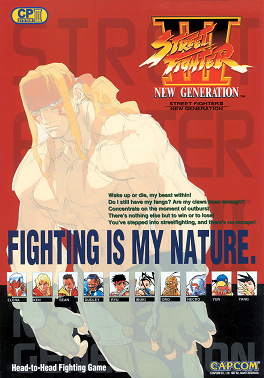
Street Fighter III: New Generation is a fighting game in Capcom's Street Fighter series, originally released as a coin-operated arcade game in 1997. The game's name as it appears on the cabinet is Three: A New Generation of Street Fighters. Street Fighter III was produced for the CD-ROM-based CP System III hardware, which allowed for more elaborate 2D graphics than the CPS II-based Street Fighter Alpha games, while revamping many of the play mechanics. The game, which was designed as a direct sequel to Street Fighter II, initially discarded every previous character except for Ryu and Ken, introducing an all-new roster led by Alex. Likewise, a new antagonist named Gill took over M. Bison's role from the previous games as the new boss character.

Ryu is a fictional character and the protagonist of Capcom's Street Fighter series. Having premiered in the first Street Fighter in 1987, Ryu appears as the game's lead character alongside his best friend and friendly rival Ken Masters. Other games in the series show Ryu to be highly focused on his training, aiming to become the strongest he can. Unable to control his dark nature, Ryu developed two alter egos: Evil Ryu, and Kage-naru mono or simply Kage.

Super Street Fighter II: The New Challengers is a competitive fighting game produced by Capcom and originally released as an arcade game in 1993. It is the fourth game in the Street Fighter II sub-series of Street Fighter games, following Street Fighter II: Hyper Fighting. It refines and balances the existing character roster from the previous versions, and introduces four new characters. It is the first game on Capcom's CP System II hardware, with more sophisticated graphics and audio over the original CP System hardware used in previous versions of Street Fighter II.
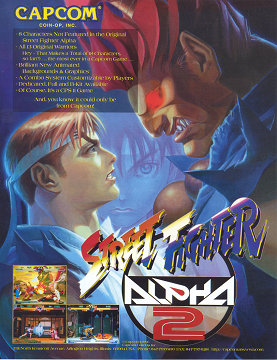
Street Fighter Alpha 2, known as Street Fighter Zero 2 in Japan, Asia, South America, and Oceania, is a 1996 fighting game originally released for the CPS II arcade hardware by Capcom. The game is a remake to the previous year's Street Fighter Alpha: Warriors' Dreams. The game features a number of improvements over the original, such as new attacks, stages, endings, and gameplay features. It was followed by Street Fighter Alpha 3.
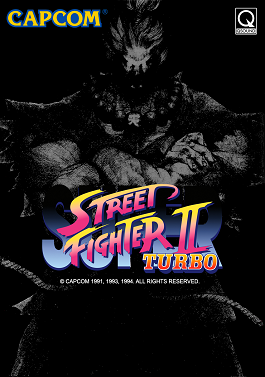
Super Street Fighter II Turbo is a fighting game released for the arcades by Capcom in Japan on February 23, 1994, in North America on February 23 and March 26, 1994 (beta) and in Europe in March 1994 (beta). It is the fifth installment in the Street Fighter II sub-series of Street Fighter games, following Super Street Fighter II: The New Challengers. Like its predecessor, it ran on the CP System II hardware.

Street Fighter Alpha 3, released as Street Fighter Zero 3 in Japan, Asia, South America, and Oceania, is a 2D fighting game originally released by Capcom for the arcade in 1998. It is the third and final installment in the Street Fighter Alpha sub-series, which serves as a sequel to Street Fighter Alpha 2, and ran on the same CP System II hardware as previous Alpha games. The game was produced after the Street Fighter III sub-series has started, being released after 2nd Impact, but before 3rd Strike. Alpha 3 further expanded the playable fighter roster from Street Fighter Alpha 2 and added new features such as selectable fighting styles called "isms".

Kung-Fu Master, known as Spartan X in Japan, is a side-scrolling beat 'em up developed by Irem as an arcade video game in 1984, and distributed by Data East in North America. Designed by Takashi Nishiyama, the game was based on Hong Kong martial arts films. It is a loose adaptation of the Jackie Chan, Sammo Hung, and Yuen Biao film Wheels on Meals (1984), called Spartan X in Japan, with the protagonist Thomas named after Jackie Chan's character in the film. The game is also heavily inspired by the Bruce Lee film Game of Death (1972), which was the basis for the game's concept. Nishiyama, who had previously designed the side-scrolling shooter Moon Patrol (1982), combined fighting elements with a shoot 'em up gameplay rhythm. Irem and Data East exported the game to the West without the Spartan X license.

Yie Ar Kung-Fu is an arcade fighting game developed and published by Konami. It first had a limited Japanese release in October 1984, before having a wide release nationwide in January 1985 and then internationally in March. Along with Karate Champ (1984), which influenced Yie-Ar Kung Fu, it is one of the games that established the basis for modern fighting games.

Trojan is a side-scrolling action game developed by Capcom, originally released as a coin-operated arcade video game in 1986, and published in North America by Romstar and Capcom. Directed by Takashi Nishiyama, the game includes beat 'em up and hack-and-slash elements. It is a spiritual successor to the beat 'em up Kung-Fu Master (1984), which was designed by Nishiyama at Irem before he left for Capcom, where he evolved its gameplay concepts with Trojan. It is also considered a spiritual successor to Capcom's Ghosts 'n Goblins (1985), which has similar side-scrolling action gameplay elements.

Street Fighter III: 2nd Impact - Giant Attack is a competitive fighting game produced by Capcom that was released as a coin-operated arcade game in 1997. It is an update of Street Fighter III: New Generation. Like its predecessor, it runs on the CP System III hardware. 2nd Impact introduced new gameplay mechanics, new characters, and new special moves. The game also brings back bonus rounds, not seen in the series since Super Street Fighter II. It is also the only CPS3 title to have a widescreen feature.

Fatal Fury: King of Fighters, known as Garō Densetsu: Shukumei no Tatakai in Japan, is a 1991 head-to-head fighting game released by SNK for the Neo Geo arcade and home platforms. Fatal Fury was SNK's first fighting game for the Neo Geo system and served as the inaugural game in their Fatal Fury series, as well as the first game to depict the fictional "King of Fighters" tournament, which became the basis for the later The King of Fighters games.

Avengers, sometimes known as Avenger and known in Japan as Hissatsu Buraiken, is a 1986 overhead-view vertical scrolling beat 'em up arcade game developed and published by Capcom. The game was directed by Takashi Nishiyama, who previously designed the side-scrolling beat 'em ups Kung-Fu Master (1984) and Trojan (1986), and later designed the original Street Fighter (1987) and several early SNK fighting games.

Street Fighter IV is a 2.5D fighting game published by Capcom, who also co-developed the game with Dimps. It was the first original main entry in the series since Street Fighter III in 1997, a hiatus of eleven years.

Street Fighter Alpha: Warriors' Dreams, known as Street Fighter Zero in Japan, Asia, South America, and Oceania, is a 2D arcade fighting game by Capcom originally released in 1995 for the CP System II hardware. It was the first all new Street Fighter game produced by Capcom since the release of Street Fighter II in 1991. The working title for the game was Street Fighter Legends.
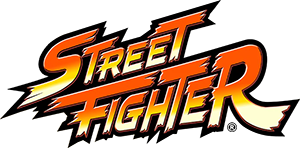
Street Fighter is a Japanese media franchise centered on a series of fighting games developed and published by Capcom. The first game in the series was released in 1987, followed by six other main series games, various spin-offs and crossovers, and numerous appearances in other media. Its best-selling 1991 release Street Fighter II established many of the conventions of the one-on-one fighting genre.

Street Fighter: The Movie is a 1995 fighting game released as an arcade game. The game is based on the 1994 live-action Street Fighter film, itself based on the Street Fighter series of fighting games, and uses digitized images of the film's cast. The game was developed by Chicago-based Incredible Technologies and distributed to the arcades by Capcom.
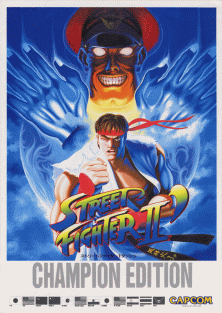
Street Fighter II: Champion Edition, released as Street Fighter II Dash in Japan, is a fighting game released by Capcom in 1992. It was launched for arcades and converted to several video game consoles. It is the first of several updated versions of Street Fighter II, and part of the Street Fighter series. The main changes are the addition of the four grand masters as playable characters and mirror matches. The fighting techniques of the eight main characters from the original game were further balanced for competitive play.
Takashi Nishiyama, sometimes credited as "Piston" Takashi Nishiyama or T. Nishiyama, is a Japanese video game designer, director and producer who worked for Irem, Capcom and SNK before founding his own company Dimps. He is best known for developing Kung-Fu Master, Street Fighter, Fatal Fury, and The King of Fighters.




















